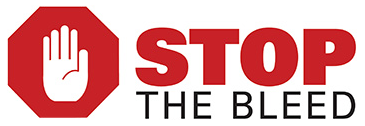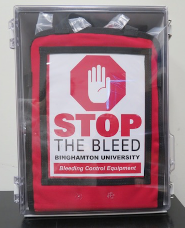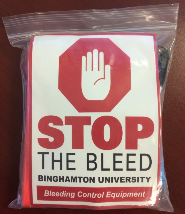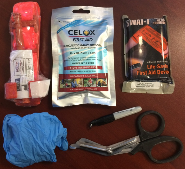
No matter how rapid the arrival of professional emergency responders, bystanders will always be first on the scene. A person who is bleeding can die from blood loss within five minutes; therefore it is important to quickly stop the blood loss.
"Stop the Bleed" is a nationwide campaign to empower individuals to act quickly and save lives. Bystanders can take simple steps to keep the injured person alive until appropriate medical care is available.
The greater the number of people who know how to control bleeding in an injured patient, the greater the chances of surviving that injury. You can help save a life by knowing how to stop bleeding if someone, including yourself, is injured.
Where to Find Them:
Binghamton University has placed bleeding control equipment throughout all University-owned/operated property:
How to Use Them:
During an Emergency:
The ABCs of bleeding control:
A = Alert: call 9-1-1 or tell somebody to call 9-1-1
B = Bleeding: Find the bleeding injury
C = Compress: Apply pressure to stop the bleeding by...
-
-
-
- Covering the wound with a clean cloth and applying pressure by pushing directly on it with both hands, or
- Using a tourniquet, or
- Packing (stuffing) the wound with gauze or a clean cloth and then applying pressure with both hands.
-
-
Ensure Your Own Safety
- Before you offer any help you must ensure your own safety! If you become injured, you will not be able to help the victim.
- Provide care to the injured person if the scene is safe for you to do so. If, at any time, your safety is threatened, attempt to remove yourself (and the victim if possible) from danger and find a safe location.
- Protect yourself from blood-borne infections by wearing gloves, if available.
The only thing more tragic than a death from bleeding...
IS A DEATH THAT COULD HAVE BEEN PREVENTED.
Bleeding
- Find the source of the bleeding.
- Open or remove the clothing over the wound so you can clearly see it.
- Look for and identify "life-threatening" bleeding.
What is "life threatening" bleeding?
-
-
-
-
- Blood that is spurting out of the wound.
- Blood that won't stop coming out of the wound.
- Blood that is pooling on the ground.
- Clothing that is soaked with blood.
- Bandages that are soaked with blood.
- Loss of all or part of an arm or leg
- Bleeding from a victim who is now confused or unconscious.
-
-
-
Compress
There are a number of methods that can be used to stop bleeding and they all have one thing in common — compressing a bleeding blood vessel in order to stop the bleeding.
If you don't have a trauma first aid kit:
Apply direct pressure on the wound.
Cover the wound with a clean cloth and apply pressure by pushing directly on it with both hands.
If you do have a trauma first aid kit:
Apply the tourniquet.
For life-threatening bleeding from an arm or leg and a tourniquet is NOT available OR the bleeding is from the neck, shoulder or groin:
Pack (stuff) the wound with bleeding control (also called a hemostatic dressing) gauze, plain gauze or a clean cloth and then apply pressure with both hands.
Usage Guides
CONTENT WARNING: Illustrated Depictions of Blood
The following guides demonstrate the use of this equipment:




